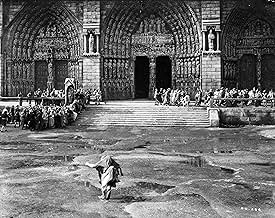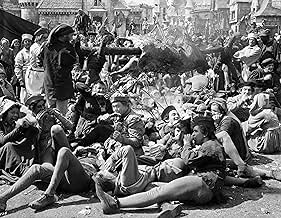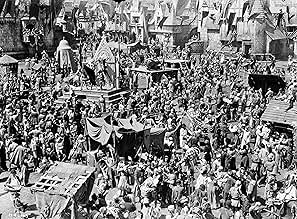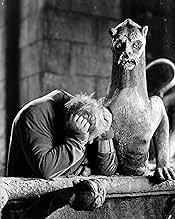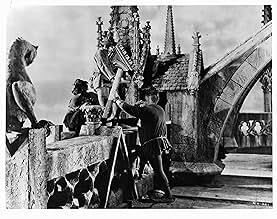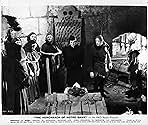In 15th-century France, a gypsy girl is framed for murder by the infatuated Chief Justice, and only the deformed bellringer of Notre Dame Cathedral can save her.In 15th-century France, a gypsy girl is framed for murder by the infatuated Chief Justice, and only the deformed bellringer of Notre Dame Cathedral can save her.In 15th-century France, a gypsy girl is framed for murder by the infatuated Chief Justice, and only the deformed bellringer of Notre Dame Cathedral can save her.
- Nominated for 2 Oscars
- 2 nominations total
Cedric Hardwicke
- Frollo
- (as Sir Cedric Hardwicke)
Helene Reynolds
- Fleur de Lys
- (as Helene Whitney)
Minna Gombell
- Queen of Beggars
- (as Mina Gombell)
Rod La Rocque
- Phillippe
- (as Rod LaRocque)
- Director
- Writers
- All cast & crew
- Production, box office & more at IMDbPro
Storyline
Did you know
- TriviaFor the scene in which Quasimodo is whipped, Charles Laughton instructed an assistant director to twist his ankle outside of camera range so he would really be in pain. Even through the heavy hump and rubber body suit, he felt every lash and often came home badly bruised. Before the 16th take, director William Dieterle whispered to him, "Now, Charles, listen to me. Let's do it one more time, but this time I want you . . . I want you to suffer." According to Laughton's wife, Elsa Lanchester, the actor never forgave him for that.
- GoofsThe cathedral is shown as having a full flight of steps up to the front doors. Notre Dame has always been more or less level with the square (le Parvis).
- Quotes
[Last lines]
Quasimodo, the bell-ringer: [to one of the stone gargoyles] Why was I not made of stone - like thee?
- Crazy creditsPROLOGUE: "With the end of the 15th Century, the Middle Ages came to a close. Europe began to see great changes. France, ravaged by a hundred years of war, at last found peace. The people under Louis XI felt free to hope again --- to dream of progress. But superstition and prejudice often stood in the way, seeking to crush the adventurous spirit of man."
- Alternate versionsAlso available in a computer colorized version.
- ConnectionsEdited into The Clock (2010)
- SoundtracksAve Maria
(1572) (uncredited)
Music by Tomás Luis de Victoria
Sung by mixed chorus during opening credits
Featured review
A sweeping claim? Perhaps. But despite the presence in Hollywood over sixty subsequent years of Ford, Wyler, Kubrick, Coppola, Scorsese et al, The Hunchback of Notre Dame remains as fresh, as emotionally resonant and yes as powerfully artistic as the day it was made. What constitutes 'art' is of course a personal matter, just as the Breughel-like compositions of Hunchback might be as mystifying to someone whose favourite film is A Clockwork Orange (Lichtenstein?). But what makes Hunchback so satisfying as art is precisely that its makers didn't set out with art in mind. Dieterle and his co-creators embarked on the project with the aim of telling a great yarn, making it look authentic, and above all ENTERTAINING the audience. It is to this end that the Grand Guignol excesses of the novel were trimmed or altered, and the Hollywood bittersweet ending imposed. Audiences filed out with their Kleenex in hand having witnessed a three-ring circus of a movie, then went home to read the war-soaked newspapers.
Virtually every frame of this movie could be taken in isolation, made into a poster and hung on a wall. Examples include Gringoire cradling the dying Clopin as a rivulet of lead trickles past in the background, the voyeuristic eye of Quasimodo peering through fence palings at the dancing Esmeralda - I could go on and on. And pervading it all is the magnificent score of Alfred Newman, surely his finest ever.
Rather than sing its obvious praises, the film can simply speak for itself. As narrative, as character, as cinema craft, it is totally successful throughout. The Hunchback of Notre Dame is my favourite film of all time, bar none. Ten out of ten
Virtually every frame of this movie could be taken in isolation, made into a poster and hung on a wall. Examples include Gringoire cradling the dying Clopin as a rivulet of lead trickles past in the background, the voyeuristic eye of Quasimodo peering through fence palings at the dancing Esmeralda - I could go on and on. And pervading it all is the magnificent score of Alfred Newman, surely his finest ever.
Rather than sing its obvious praises, the film can simply speak for itself. As narrative, as character, as cinema craft, it is totally successful throughout. The Hunchback of Notre Dame is my favourite film of all time, bar none. Ten out of ten
- jeffbertucen@hotmail.com
- Dec 11, 2002
- Permalink
Details
- Release date
- Country of origin
- Official site
- Language
- Also known as
- Victor Hugo's Immortal Classic The Hunchback of Notre Dame
- Filming locations
- Production company
- See more company credits at IMDbPro
Box office
- Budget
- $1,800,000 (estimated)
- Runtime1 hour 56 minutes
- Color
- Aspect ratio
- 1.37 : 1
Contribute to this page
Suggest an edit or add missing content

Top Gap
By what name was The Hunchback of Notre Dame (1939) officially released in India in English?
Answer

